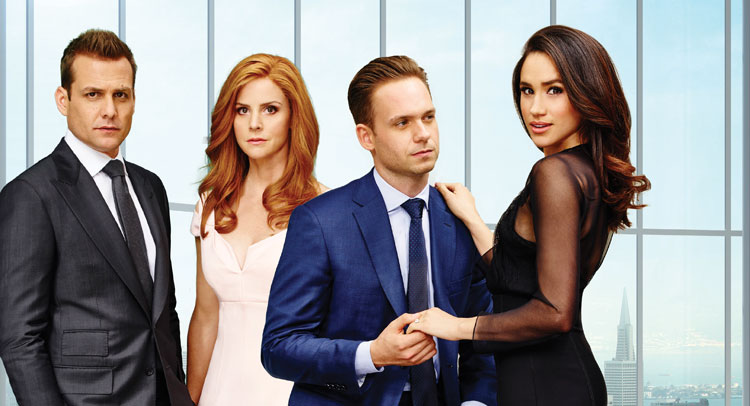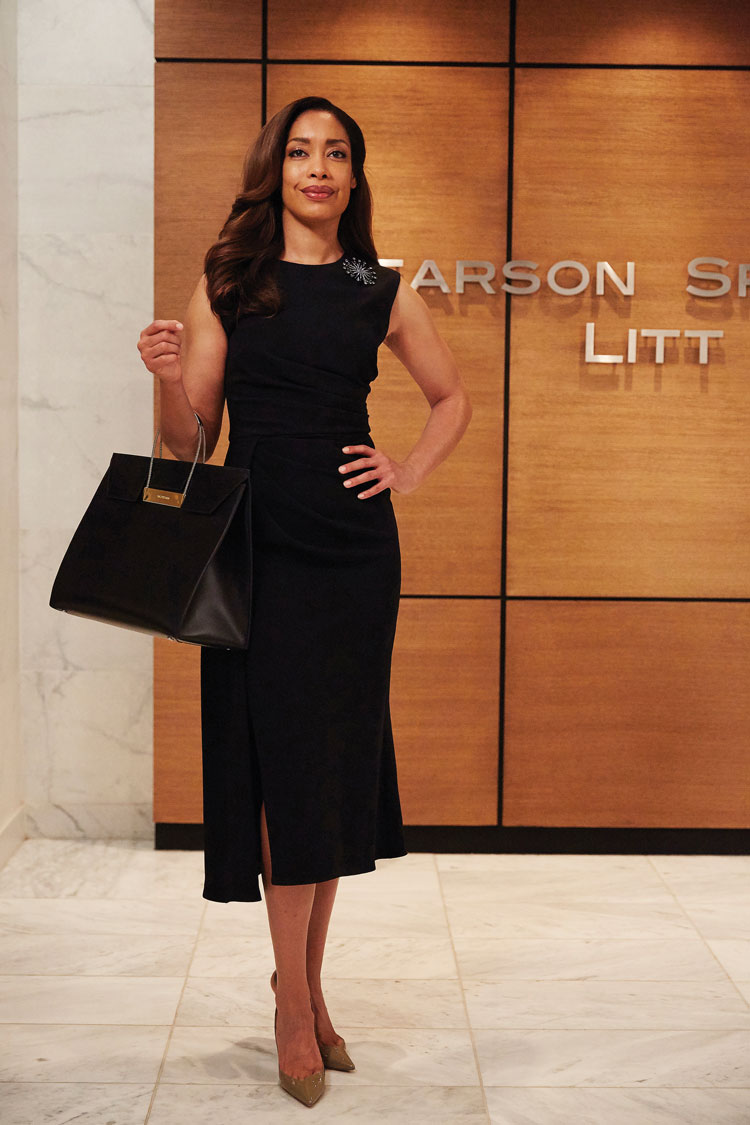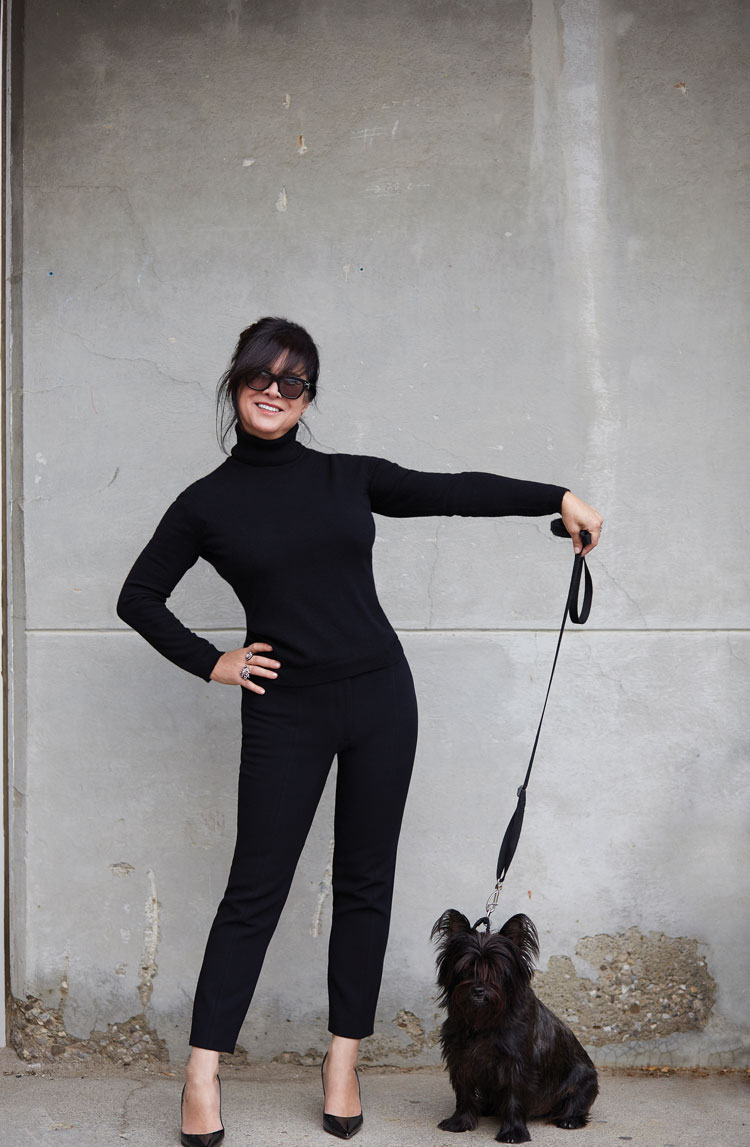Lawyer fashion evolves to reflect personality and tradition

Photo by USA Network.
NOT TOO TAILORED
Hand agrees there has been a resurgence in tailored clothing, but he cautions against overdoing it. “You don’t want to be taken within firm culture as dressing as if you’ve already made it,” he says.
“It all goes back to the laws of style: It drives gentlemen to the perfect mean. It will bring your style game up significantly, but if you’re the peacock in jeopardy of being that fashionable guy at the firm, it will rein you in a bit. Two words that I think are key in how I want to present myself and how any lawyer should: capable and elegant,” he adds.
For men, Hand recommends four fundamental suits every lawyer should own: a blue pinstripe, gray flannel, flat blue and charcoal pinstripe.
“I would overspend in this area because these are suits you can wear over and over again,” Hand says. “And a black suit, at least to me, is a tuxedo.”
Hand says his favorite suit, which he’s had for years, is an olive green, peaked-collar, double-breasted piece by Brioni. “But did I wear it in my first six years of practice? Not once. One, it made me look like I was trying to look like a partner, and I was at a firm with mostly investment banker clients. I needed to look like I was grinding away on their M&A deals, not on the terrace of a hacienda.”
Hand now works for fashion industry clients, which he says allows him more sartorial license.
THE CASE FOR FLAIR

Jessica Pearson (portrayed by Gina Torres)—a firm co-founder and former managing partner on the TV show “Suits”—never wears the same outfit twice. Photo by USA Network.
You never get a second chance to make a first impression. This adage couldn’t be more critical than in the courtroom, where the arbiters might be weighing the legal case but also judging those making the arguments.
“It has been found that in the first 30 seconds of meeting someone, people will form an opinion of you, and most of what they’re going to interact with is your appearance,” Hand says. “Not the RICO statute or the ’34 Act but what you look like. So if you look elegant and capable, that’s a good thing. But if you look like a schlub who doesn’t pay attention to the details, that’s not good.”
Shelley Duff recognized the power of personal style while she worked on a homicide trial as an assistant public defender in Pittsburgh in 2011. Duff was meticulous about how she dressed—carefully planning her ensembles from her sparkly earrings to her stilettos. The case ended up with a hung jury, and when Duff had a chance to talk to jurors about the verdict, she was surprised by what she heard.
“One girl said, ‘I couldn’t wait to see what you were going to wear every day!’ I remember thinking, ‘They are looking; they pay attention to that kind of stuff.’ It’s something you don’t really think about, but you’re making an impression on the jury by what you wear. I don’t know if that’s good or bad, but it’s definitely something to think about,” she says.
Duff now works in private practice in Pittsburgh, but she hasn’t changed her approach to dressing. On top of being a career criminal defense attorney, Duff is a musician, so she gets to have fun with what she wears on stage. But she also lets her light shine through in court and at client meetings.

Jolie Andreatta: “It’s talent and craftsmanship that was starting to go away, and it seems to be coming back again.” Photo by USA Network.
“As a lawyer, it’s a balance of being respectful and being an individual,” Duff says. “I want clients to have confidence in me and not to look disheveled. If you come in dressed sharply, it gets attention. People feel good and have confidence in you, and I definitely think that’s important.
“We have people looking at jail time or facing serious consequences. When someone meets me for the first time, you do have to fit that stereotype of what a lawyer’s going to look like,” she adds.
To that end, Duff says she always pulls back her hair, but she’ll still throw on a pair of spiked high heels. Her look changes when she visits clients in jail or has a trial. That’s when her dress becomes more conservative.
THE BENCH RULES
According to Scafidi, the rules vary from court to court, jurisdiction to jurisdiction. “In family court, you dress differently than you would in criminal court or appellate court,” she says.
“With that being said, it is still true that the courtroom is the last bastion of formality in America. We’ve stopped dressing up for the theater, for church, but when it comes to court, there are still rules,” Scafidi adds.
Duff says she still likes to express herself with a fun scarf or bright jewelry, and she has some blazers with leather embellishments. But the idea isn’t to look glamorous in court. “The law still has that aspect of tradition. It doesn’t let you go too far, but I try to push the boundaries of what I wear and still be respectful,” she says.
“And as you gain a reputation in the community and courthouse, you get a little more flexibility. People know who you are; they know your reputation,” Duff adds.
“Everyone at court knows I’m a musician. I’d come in trying to hide the blue streaks in my hair, but people would say, ‘Do you have blue in your hair? We like it—it’s interesting.’ ”
Nonetheless, courtroom attire remains relatively conservative. “I remember a judge not talking to me until I went and got a jacket,” says Brown of DLA Piper. “I had on slacks and a blouse.”
Brown counsels lawyers at her firm to help them impress and snag clients, and this can involve advice on personal presentation and style. She emphasizes that a winning look doesn’t have to be cookie-cutter, and that letting personality shine through can help. After all, if you look good you feel good, and confidence resonates.
“I tell people: ‘Whatever you feel best in’—I’m not talking about ripped jeans—‘is what you perform best in,’ ” Brown says. “But what I don’t believe is that you have to dress like a man version of something to be professional, a respected lawyer and appropriate.”
This article was published in the February 2018 ABA Journal magazine with the title "What Suits You? Lawyer fashion evolves to reflect both personality and tradition."



